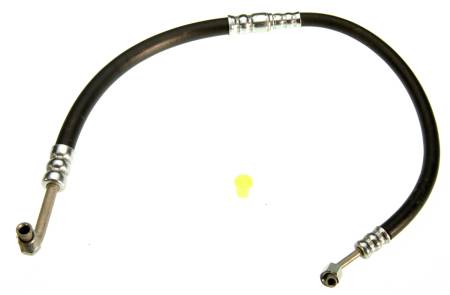Maintenance & Troubleshooting
Signs of Wear & Troubleshooting
- Difficulty steering and/or visible power steering fluid leakage can indicate the need for hose maintenance or replacement.
- Hose brittleness or hardness can be an early sign of internal wear. This may mean that the hose has lost its ability to absorb pressure surges.
- A soft, spongy hose is a more serious sign of wear that indicates advanced internal deterioration and probably leakage. Leakage is easily detected by a visual inspection of the hose and its fittings.
- External wear and abrasion is caused by contact with the manifold or other engine parts. This issue may require hose replacement or realignment.
- Thick, sludgy fluid in the pump reservoir indicates internal hose wear and the need for a complete flush of the system.
- High temperature pulsations cause power steering hoses to deteriorate from the inside. The constant flexing and pressure surges result in the breaking off of small particles of hose, which are carried through the system and can lead to system malfunction.
Good Maintenance Practices
- Inspection of power steering hoses eliminates expensive repairing or replacing of the pump or other components.
- Hoses should be replaced after 20,000 - 24,000 miles as preventative maintenance.
- Check power steering fluid levels periodically and add fluid when necessary.
- Have your vehicle inspected if it exhibits any of the following symptoms: unusual noise when turning the steering wheel, a shimmy or shake in the steering wheel, heavy or unresponsive steering at low speeds or during parking lot maneuvers, and/or the steering wheel does not return to 'center' properly.
- If you live in areas that experience harsh, winter weather, have the entire steering system inspected before winter arrives to help ensure safer driving.
- It is a good idea to replace O-rings when doing any steering system service. Reusing old O-rings can cause leaks.
- Always check the specific manufacturer's service information for the correct power steering fluid to use. Different fluids are specified by the manufacturers to meet the operating requirements of their power steering systems. On some modern steering systems, brake fluids or transmission fluids may not be compatible with pump components. Using the wrong fluid could cause hose and seal damage as well as fluid leaks.
- Keep in mind that regardless of the original color of new power steering fluid, all fluids will darken in color during use. Fluid color is not an indication of fluid condition.
- After any service of the power steering system, always bleed the air from the system and verify proper system operation. An accurate fluid level cannot be obtained unless air is bled from the steering system. The air in the fluid may cause pump cavitation noise as well as pump damage over a period of time.

 WARNING: Cancer & Reproductive Harm -
WARNING: Cancer & Reproductive Harm -
Write the First Review!